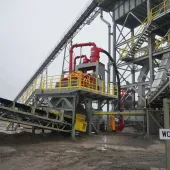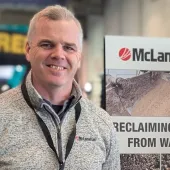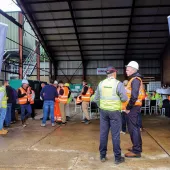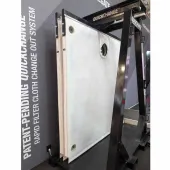Selecting the Right Crushing Equipment
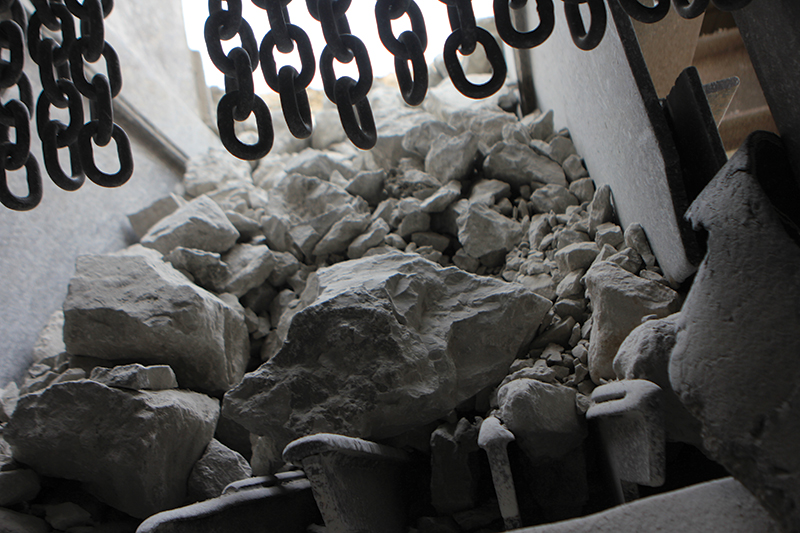
First published in the September 2015 issue of Quarry Management
Gerry Mangrich, regional sales manager - aggregate processing with McLanahan Corp., outlines the main crushing stages and examines the key characteristics of the main crusher types
Most aggregate producers are well acquainted with the selection of crushing equipment and know it is possible to select a piece of equipment based solely on spec sheets and gradation calculations. However, theoretical conclusions must always be weighed against practical experience regarding the material at hand and of the operation, maintenance and economical aspects of different solutions. In general, material reduction is handled in stages. Although there are some single-crusher systems, the most common systems involve at least two or three crushing stages.
Crushing stages
Primary crushing
The duty of the primary crusher is, above all, to make it possible to transport material on a conveyor belt. In most aggregate crushing plants, primary crushing is carried out in a jaw crusher, although a gyratory primary crusher may be used. If material is easily crushed and not excessively abrasive, an impact breaker could also be the best choice as a primary crusher.
The most important characteristics of a primary crusher include the capacity and ability to accept raw material without blockages. A large primary crusher is more expensive to purchase than a smaller machine; for this reason, investment cost calculations for primary crushers are weighted against the costs of blasting raw material to a smaller size. In most cases, raw material is transported by trucks to a fixed primary. The costs of fuel, tyres, maintenance and return on investment should also be considered. This can be an expensive solution.
A pit-portable primary crusher can be an economically sound solution in cases where the producer is crushing at the quarry face. In modern plants, it is often economically advantageous to use a moveable primary crusher so it can follow the movement of the face where raw material is extracted. The most common use of track-mounted primary crushers is in applications intended for short-term contracts or where frequent moves are necessary.
Intermediate (secondary) crushing
The purpose of intermediate crushing is to produce various coarser fractions, eg basecourse, or to prepare the material for final crushing. If the intermediate crusher is used to make railway ballast, product quality is important. In other cases, there are normally no quality requirements, although the product must be suitable for fine crushing. In most cases, the objective is to obtain the greatest possible reduction at the lowest possible cost.
Fine (tertiary) crushing
In this crushing stage, the quality and quantity of fine products are determined. Quality requirements can be stringent for the final products, especially within the aggregate industry. Customer requirements common to both the aggregate and mining industries are capacities and quality (fraction/particle size). The aggregate industry has additional quality demands such as soundness and particle shape (cubicity).
In most cases, the fine crushing and cubicizing functions are combined in a single crushing stage. The selection of a crusher for tertiary crushing calls for both practical experience and theoretical know-how. This is where producers should call in an experienced applications specialist to make sure a system is properly engineered.
Types of crushers
Most crushers used for aggregate production fall into one of three main categories/types:
- Compressive crushers – which squeeze the material until it breaks
- Impact crushers – which use the principle of rapid impact to shatter the material
- Attrition crushers – which use both impact and grinding to shear the material.
- Jaw crushers, cone crushers, gyratory crushers and roll crushers all operate on the compression principle. Impact crushers utilize the impact principle, while hammermill crushers follow the principle of attrition.
Compression crushers
Jaw crushers
Jaw crushers are often used as primary crushers and are perhaps the most popular crusher worldwide. They are suitable for almost any type of material.
Crushing takes place between a stationary jaw plate and a moving jaw plate. The moving jaw plate is mounted on the pitman, which is given a reciprocating motion. Crushing takes place when the pitman moves toward the stationary jaw.
There are two main types of jaw crushers – single toggle and double toggle.
The single-toggle jaw crusher features a pitman mounted on an eccentric shaft at the top. At the bottom of the assembly, the pitman is held in position by a toggle plate. The combination of eccentric motion at the top and rocking motion at the bottom provides a positive downward thrust throughout the crushing chamber.
The double-toggle crusher has two shafts. One is a pivot shaft from which the pitman hangs whist the other is an eccentric shaft which stimulates the two toggle plates. The pitman is given a purely swinging motion toward the stationary jaw.
Single-toggle jaw crushers have better feed acceptance capability than the corresponding double-toggle crushers. Jaw crushers are reliable, robust machines, offering a 6:1 reduction ratio in most materials, and will accommodate hard, abrasive materials.
Roll crushers
Roll crushers are a compression-type reduction crusher with a long history of success in a broad range of applications. The crushing chamber is formed by massive drums which revolve towards one another. The gap between the drums is adjustable, and the outer surface of the drum comprises heavy manganese steel castings, known as roll shells, that are available with either a smooth or corrugated crushing surface.
Double-roll crushers offer up to a 3:1 reduction ratio in some applications, depending on the characteristics of the material. Triple-roll crushers offer up to a 6:1 reduction. As a compressive crusher, the roll crusher is well suited to extremely hard and abrasive materials. Automatic welders are available to maintain the roll shell surface and minimize labour expense and wear costs.
Roll crushers are rugged, dependable machines, but not as productive as cone crushers with respect to volume. However, roll crushers provide very close product distribution and are excellent for chip stone, particularly when looking to avoid fines.
Cone and gyratory crushers
Cone and gyratory crushers are both gyrating-shaft machines. They have a main shaft that gyrates and provides the crushing motion. Crushing takes place between a fixed outer crusher member (the concave ring) and a moving inner crushing member (the mantle) mounted on the gyrating shaft assembly.
A roller-bearing type cone crusher functions the same as a shaft-type cone. The main difference is the rotating wedge found in roller-bearing cones that causes the gyrating motion of the mantle. It commonly features a flatter angle in the crushing chamber compared with shaft-type cones.
It is usually recommended that cone crushers operate with the crushing chamber full (ie choke fed). Cone and gyratory crushers are typically used in abrasive materials of considerable hardness. Due to high investment value, they are used in cases where impact crushers are not appropriate.
Impact crushers
Primary impact breakers
Primary breakers are noted for large expansion chambers above one or two revolving rotor assemblies. As the rock falls into the rotor circle it is struck by manganese hammers fixed on to the outer surface of the rotor(s). The rock shatters upon impact with the hammers, sprays against the back wall of the impactor, and then tumbles back into the hammer circle. When crushed to size, material passes an adjustable bar to exit the crusher.
These breakers are ideal for limestone quarries and are known to provide 20:1 reduction or even as much as 40:1 reduction in the case of a double-rotor configuration. The expansion chamber allows stone to shatter at its weakest fissures, minimizing fines while generating a high percentage of –40mm product with superior soundness. They are also noted for their ability to accept a maximum feed size much larger than other primary crushers.
Primary impact breakers, while very productive, may require additional maintenance expense relating to the hammers (blow bars). Some models offer limited access, and in the face of rising labour costs, maintaining an old impact breaker may be more expensive than a primary horizontal-shaft impact crusher.
Primary horizontal-shaft impact (HSI) crushers
Horizontal-shaft impactors are noted for their accessibility with a housing that opens like a clam shell. Primary HSIs are generally equipped with two adjustable curtains (aprons) and a rotor assembly with hammers (blow bars) that are easily accessible and offer multiple wear surfaces. They are a low-profile design compared with primary breakers and have a limited expansion area above the rotor.
Quarry shot material enters the crusher and, upon impact with the hammers, strikes the curtain(s) and immediately rebounds back into the hammer circle. In a typical two-curtain impactor, the initial curtain is often set at around 300mm followed by a 120mm gap setting on the second curtain.
Reduction ratios associated with primary HSI crushers range from 4:1 to 6:1, depending on the material characteristics. Maximum feed size varies with each model, but is generally limited to around 600–900mm. The output gradation of the primary HSI crusher is generally coarser than the primary breaker due to the lack of expansion above the rotor, which also affects the capacity. Primary HSI crushers are considerably wider than primary breakers at comparable capacity ratings.
Secondary horizontal-shaft impact (HSI) crushers
These crushers are characterized by a high 10:1 reduction ratio and by their suitability for generating a cubical product. They can also be used for a variety of applications.
Secondary impact crushing is commonly used to improve product soundness and remove deleterious materials. As with primary HSI crushers, these secondary impactors, which open like a clam shell, are equipped with two or more adjustable curtains (aprons) and a rotor assembly with hammers (blow bars) that are easily accessible and offer multiple wear surfaces.
These high-production crushers incorporate chromium alloy wear parts that allow for economical use on materials with abrasive characteristics. Some secondary HSI crushers offer curtains that can be added in the field for increased production of chip stone. Secondary HSI crushers have become very versatile with multiple rotor configurations, special alloy wear parts, and maintenance features designed to reduce both downtime and the cost of ownership.
Vertical-shaft impact (VSI) crushers
Generally recognized as tertiary crushers, vertical-shaft impact crushers have material fed into the centre of the crusher, through a feed tube, and on to the centre of a rotating table or rotor. The material is then accelerated to high velocity and thrown into the anvil ring or outer shell. Crushing takes place upon impact with the anvil ring or against other material that is in the rock shelf (rock on rock). Product gradation in vertical-shaft impactors is controlled primarily by the speed of the table or rotor.
Attrition crushers
Hammermill crushers
Hammermills are similar to impact crushers in the upper chamber where the hammer impacts the in-feed of material. The difference is that the rotor of a hammermill carries a number of ‘swing-type’ or pivoting hammers. Hammermills also incorporate a grate circle in the lower chamber of the crusher. Grates are available in a variety of configurations. The product must pass through the grate circle as it exits the machine, ensuring controlled product sizing.
Hammermills are generally used to crush or pulverize materials that have low abrasion characteristics. The rotor speed, hammer type and grate configuration can be converted for different applications. They can be used in a variety of applications, including primary and secondary reduction of aggregates, as well as numerous industrial applications.
- Subscribe to Quarry Management, the monthly journal for the mineral products industry, to read articles before they appear on Agg-Net.com


